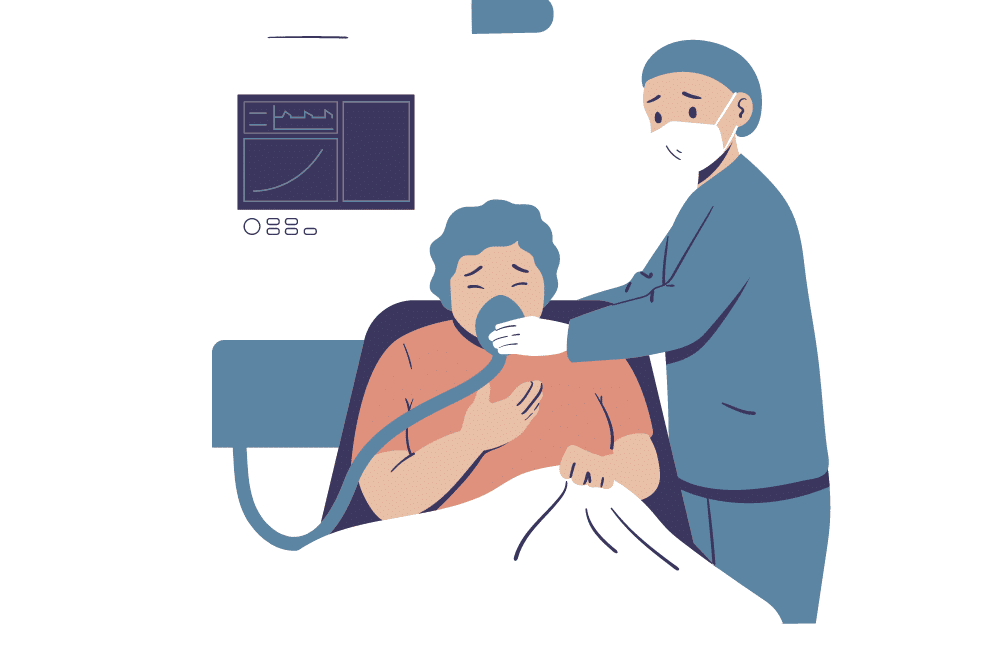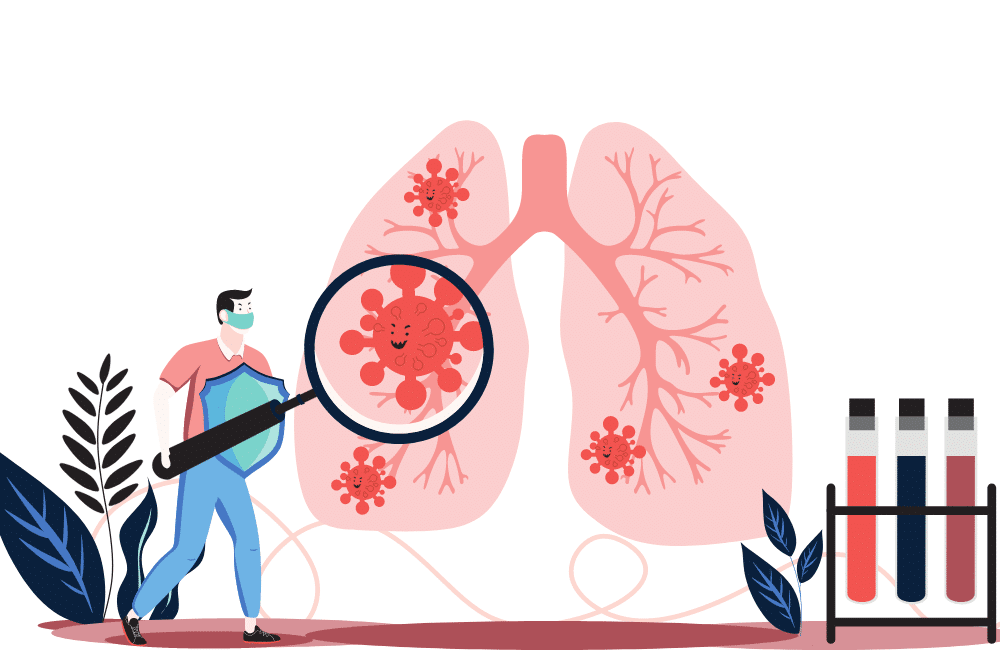Shortness of breath, or dyspnea, is a common medical symptom that can be distressing and frightening. It is characterized by the sensation of being unable to catch one’s breath or feeling breathless. While shortness of breath can be a normal response during physical exertion, it may also indicate an underlying medical condition.

In this comprehensive article, we will explore the causes of shortness of breath and its symptoms and offer practical tips on dealing with it effectively.
Understanding Shortness of Breath
Shortness of breath is a condition that occurs when there is a disruption in the normal breathing process. It can be caused by various factors, ranging from benign causes to more serious medical conditions. Common triggers for shortness of breath include:
Physical Exertion
Physical exertion, often in strenuous activities like running, cycling, or exercising, can cause temporary shortness of breath. It is a natural body response as it adjusts to the increased demand for oxygen and energy during these activities. Understanding this normal and healthy response is essential for individuals who engage in regular physical exercise.
1. The Body’s Oxygen Demands during Exercise
During physical exertion, the body’s oxygen demands rise significantly. Muscles require more oxygen to produce the energy necessary for movement and performance. To meet this increased demand, the body must facilitate the intake and delivery of oxygen to the working muscles.
2. The Role of the Respiratory System
The respiratory system plays a crucial role in ensuring an adequate oxygen supply to the body during exercise. It consists of organs, such as the lungs, airways, and respiratory muscles, working together to facilitate the process of breathing.
3. Increased Breathing Rate
When physical activity intensifies, the body responds by increasing the breathing rate. This allows more air to enter the lungs, facilitating the exchange of oxygen and carbon dioxide. The respiratory center in the brain detects the need for more oxygen and sends signals to the respiratory muscles, instructing them to contract and expand the lungs more rapidly.
4. Enhanced Oxygen Uptake
As the breathing rate increases, the alveoli (tiny air sacs in the lungs) receive more fresh air. Oxygen from the inhaled air diffuses into the bloodstream through the alveoli, while carbon dioxide is expelled from the bloodstream into the alveoli to be exhaled.
5. Heart Rate Adjustment
In addition to the respiratory system, the cardiovascular system adapts to the increased oxygen demands during exercise. The heart rate rises to pump oxygen-rich blood to the muscles more efficiently, supporting their enhanced activity.
6. Temporary Shortness of Breath
The increase in breathing rate, heart rate, and oxygen uptake during physical exertion may lead to a sensation of shortness of breath. This feeling of breathlessness is a normal response and is not a cause for concern in healthy individuals engaging in regular exercise.
7. The Importance of Warm-up and Gradual Progression
To minimize the intensity of shortness of breath during exercise, it is crucial to warm up before engaging in strenuous activities. A proper warm-up prepares the respiratory and cardiovascular systems for increased demands and helps prevent abrupt changes that could lead to discomfort.
Moreover, individuals new to exercise or returning after a period of inactivity should progress gradually. Gradual progression allows the body to adapt to the increased demands over time, reducing the likelihood of experiencing severe shortness of breath or overexertion.
8. When to Seek Medical Attention
While shortness of breath during exercise is normal, certain warning signs warrant medical attention. If an individual experiences severe and prolonged shortness of breath that does not improve with rest or is accompanied by chest pain, dizziness, or fainting, it is crucial to seek immediate medical help. These symptoms may indicate an underlying medical condition that requires evaluation and treatment.
Anxiety and Stress
Anxiety and stress can cause rapid, shallow breathing, leading to a feeling of breathlessness. This response is often related to the body’s fight-or-flight mechanism, which triggers an increase in respiration when faced with perceived threats.
Respiratory Infections
Respiratory infections are a common group of illnesses that affect the upper and lower respiratory tract, including the nose, throat, bronchi, and lungs. These infections range from mild conditions like the common cold to more severe diseases like influenza and pneumonia. When infections strike the respiratory system, they can lead to inflammation in the airways, which may result in shortness of breath. Understanding the relationship between respiratory infections and shortness of breath is essential for recognizing the symptoms and seeking appropriate medical care.
Types of Respiratory Infections
Several types of respiratory infections can cause shortness of breath:

Common Cold
The common cold is a viral infection primarily affecting the upper respiratory tract, including the nose and throat. While it is usually mild and self-limiting, the common cold can cause nasal congestion and throat irritation, leading to slight shortness of breath, especially if nasal congestion interferes with breathing through the nose.
Influenza (Flu)
Influenza, commonly known as the flu, is a highly contagious viral infection that affects the nose, throat, and sometimes the lungs. In more severe cases, the flu can cause viral pneumonia, leading to lung inflammation and difficulty breathing.
Bronchitis
Bronchitis is an infection of the bronchial tubes, the airways that carry air to the lungs. Viruses usually cause acute bronchitis and can lead to increased mucus production and swelling of the airways, potentially causing shortness of breath.
Pneumonia
Pneumonia is an infection that inflames the air sacs in one or both lungs. The air sacs may fill with fluid or pus, making it difficult for the lungs to function efficiently and resulting in shortness of breath.
COVID-19
COVID-19 is a respiratory illness caused by the severe acute respiratory syndrome coronavirus 2 (SARS-CoV-2). It can range from mild to severe respiratory distress, and shortness of breath is one of the hallmark symptoms, particularly in severe cases.
Mechanism of Shortness of Breath
In respiratory infections, the body’s immune response kicks in to fight off the invading pathogens. The immune response triggers inflammation in the respiratory tract as a defense mechanism. However, this inflammation can also cause swelling and narrowing of the airways, leading to difficulty in moving air in and out of the lungs.
3. Symptoms of Shortness of Breath
Shortness of breath is characterized by the sensation of not getting enough air or feeling breathless. It can vary in severity depending on the extent of inflammation and the type of infection. Other common symptoms of respiratory infections may include:
- Coughing
- Chest congestion
- Sore throat
- Fatigue
- Body aches
- Fever
4. Seeking Medical Attention
While mild shortness of breath can be expected with some respiratory infections, severe or worsening symptoms warrant immediate medical attention. If an individual experiences any of the following, they should seek medical help promptly:
- Severe shortness of breath
- Rapid breathing
- Bluish lips or face
- Confusion or disorientation
- Chest pain
- Inability to complete sentences due to breathlessness
These symptoms may indicate a more severe respiratory condition or complications that require urgent evaluation and treatment.
5. Treatment and Management
Treating respiratory infections and shortness of breath depends on the specific infection and its severity. Mild cases of viral infections generally improve with rest, hydration, and over-the-counter medications to alleviate symptoms.
In more severe cases or when shortness of breath is prominent, medical treatment may include antiviral or antibiotic medications (if bacterial pneumonia is present), supplemental oxygen therapy, and supportive care to manage symptoms and aid recovery.
Chronic Respiratory Conditions
Chronic respiratory conditions, including asthma, chronic obstructive pulmonary disease (COPD), and interstitial lung diseases, can result in persistent shortness of breath.
Cardiovascular Issues
Heart problems like heart failure, heart attacks, or arrhythmias can affect the heart’s ability to pump blood efficiently, leading to inadequate oxygen supply to the body and causing shortness of breath.
Recognizing the Symptoms
Identifying the symptoms of shortness of breath is crucial for prompt management. The severity and duration of symptoms may vary depending on the underlying cause. Common signs to watch out for include:
- Feeling Breathless
A sensation of breathlessness or not getting enough air may be mild, moderate, or severe.
- Rapid Breathing
An unusually rapid breathing rate, even during rest or minimal activity.
- Tightness in the Chest
A feeling of pressure or tightness in the chest can accompany shortness of breath.
- Wheezing
A high-pitched whistling sound when breathing is often associated with respiratory conditions like asthma.
- Bluish Lips or Fingernails
In severe cases, a lack of oxygen may cause a bluish tint in the lips or fingernails.
Dealing with Shortness of Breath
Managing shortness of breath involves addressing the underlying cause and adopting certain lifestyle changes. Below are effective ways to deal with shortness of breath:
- Consult a Healthcare Professional
If you experience persistent or recurrent shortness of breath, seek medical attention promptly. A healthcare provider will conduct a thorough evaluation to identify the root cause and recommend appropriate treatment.
- Breathing Exercises
Practicing breathing exercises can help improve lung capacity and efficiency. Techniques like diaphragmatic, pursed-lip, and deep breathing can be beneficial in reducing shortness of breath.
- Manage Stress and Anxiety
Since stress and anxiety can contribute to shortness of breath, it’s essential to learn stress-reduction techniques such as meditation, yoga, or mindfulness.
- Medication Adherence
For individuals with chronic respiratory conditions, adhering to prescribed medications is vital in managing symptoms and preventing exacerbations.
- Avoid Triggers
If certain allergens or irritants trigger shortness of breath, avoid exposure. This may include allergens like pollen, pet dander, or environmental pollutants.
- Stay Hydrated
Drinking an adequate amount of water can help keep respiratory mucous membranes moist, making it easier to breathe.
- Quit Smoking
If you smoke, quitting is one of the most significant steps to improve your respiratory health and reduce the risk of developing chronic respiratory conditions.
Final Thoughts
Shortness of breath can be a concerning symptom that warrants attention and care. Understanding the causes and recognizing the symptoms is crucial in dealing with this condition effectively. By adopting healthy lifestyle practices, seeking medical advice, and managing underlying medical conditions, individuals can alleviate shortness of breath and breathe more easily. Remember, a proactive approach to respiratory health can improve quality of life and overall well-being.

